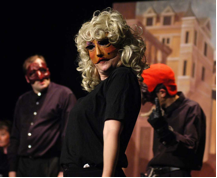L’Amfiparnaso (1597)
Masked commedia dell’arte madrigal comedy
Performers: 5 singers, 3 masked actors, lute, harpsichord
Extra requirements: Harpsichord; basic lighting
Christmas 1594: while Monteverdi makes his way at the Mantuan court, nearby Modena witnesses the first night of Vecchi’s classic commedia dell’arte work – L’Amfiparnaso.
Through a virtuosic ensemble score, Vecchi brings alive the stereotypes of late 16th-century Venice: mean-hearted old Pantalone; the verbose and bogus Doctor (speaking his own dialect called minestrone); the braggart and over-amorous Spanish Captain and the ever-hungry servants – the zanni. But alongside the slapstick (the show features an actual slapstick), Vecchi writes bittersweet music for the lovers, as fine as Gesualdo and Monteverdi.
“Both singing and acting rose to the occasion magnificently. […] Sheer bad taste and panache.” Daily Telegraph
The title – The twin peaks of Mount Parnassus – emphasises this balance of comedy and beauty, a technique to become popular from Cavalli to Mozart and beyond.
“One of the high points of Renaissance music theatre… Absolutely nothing else like this on the market. […] A triumph for I Fagiolini and Chandos and a benchmark for the DVD industry as a whole.†International Record Review
As always with commedia, the plot is a simple one of unhappy lovers, scheming old rogues and their cheeky servants. The action is mimed by actors in half-masks; the music is sung in a mix of Tuscan Italian, Venetian and other dialects.
“I Fagiolini turn a silk purse into one beaded in gold… A highly enjoyable production which celebrates the immediacy, relevance and enjoyment to be found in a 400-year old musical.” Gramophone
Each scene is introduced by a short comic spoken introduction: we work with the promoter to produce a version in the local language (so far we have English, Spanish, Portuguese, French, German, Hungarian, Czech and Flemish).
Read about the DVD here.
Read an essay about commedia dell’arte in music here.
- I was thinking that. Also @JolyonMaugham was (which carries a little more weight). https://t.co/pAu9emYdGd
- For my birthday I have done admin, walked dog, and rehearsed Walton with @The24choir https://t.co/jNTU2B3UIw https://t.co/LDhso8U9jS
- It's very reasonably priced and all those benefits.... https://t.co/DFJS8e9Dqw


